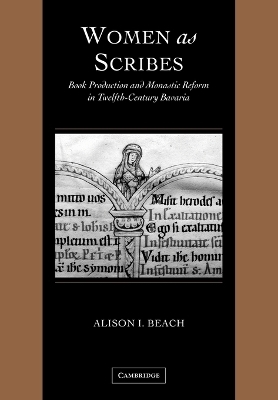
Women as Scribes
Book Production and Monastic Reform in Twelfth-Century Bavaria
Seiten
2009
Cambridge University Press (Verlag)
978-0-521-12694-6 (ISBN)
Cambridge University Press (Verlag)
978-0-521-12694-6 (ISBN)
This is a study of the role of female scribes at three different religious communities in Bavaria in the twelfth century. It shows how the women's work - in extending the increased intellectual activity of the scriptoria - supported the revival of the monastic reform movements of that period.
Professor Beach's book on female scribes in twelfth-century Bavaria - a full-length study of the role of women copyists in the Middle Ages - is underpinned by the notion that the scriptorium was central to the intellectual revival of the Middle Ages and that women played a role in this renaissance. The author examines the exceptional quantity of evidence of female scribal activity in three different religious communities, pointing out the various ways in which the women worked - alone, with other women, and even alongside men - to produce books for monastic libraries, and discussing why their work should have been made visible, whereas that of other female scribes remains invisible. Beach's focus on manuscript production, and the religious, intellectual, social and economic factors which shaped that production, enables her to draw wide-ranging conclusions of interest not only to palaeographers but also to those interested in reading, literacy, religion and gender history.
Professor Beach's book on female scribes in twelfth-century Bavaria - a full-length study of the role of women copyists in the Middle Ages - is underpinned by the notion that the scriptorium was central to the intellectual revival of the Middle Ages and that women played a role in this renaissance. The author examines the exceptional quantity of evidence of female scribal activity in three different religious communities, pointing out the various ways in which the women worked - alone, with other women, and even alongside men - to produce books for monastic libraries, and discussing why their work should have been made visible, whereas that of other female scribes remains invisible. Beach's focus on manuscript production, and the religious, intellectual, social and economic factors which shaped that production, enables her to draw wide-ranging conclusions of interest not only to palaeographers but also to those interested in reading, literacy, religion and gender history.
1. Introduction; 2. Diemut and the nun-scribes of Wessobrunn; 3. Claustration and collaboration: the nun-scribes of Admont; 4. Unlikely allies in the scriptorium: the female scribes of Schäftlarn; 5. Conclusion; Appendix A. Codicological tables; Appendix B. Ruling patterns; Bibliography; Index.
| Erscheint lt. Verlag | 3.12.2009 |
|---|---|
| Reihe/Serie | Cambridge Studies in Palaeography and Codicology |
| Zusatzinfo | Worked examples or Exercises |
| Verlagsort | Cambridge |
| Sprache | englisch |
| Maße | 170 x 244 mm |
| Gewicht | 350 g |
| Themenwelt | Geschichte ► Allgemeine Geschichte ► Mittelalter |
| Geschichte ► Hilfswissenschaften ► Paläografie | |
| Geisteswissenschaften ► Geschichte ► Regional- / Ländergeschichte | |
| Geschichte ► Teilgebiete der Geschichte ► Kulturgeschichte | |
| Geisteswissenschaften ► Sprach- / Literaturwissenschaft ► Sprachwissenschaft | |
| ISBN-10 | 0-521-12694-0 / 0521126940 |
| ISBN-13 | 978-0-521-12694-6 / 9780521126946 |
| Zustand | Neuware |
| Haben Sie eine Frage zum Produkt? |
Mehr entdecken
aus dem Bereich
aus dem Bereich
eine neue Geschichte des Mittelalters
Buch | Hardcover (2023)
C.H.Beck (Verlag)
CHF 53,20


